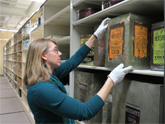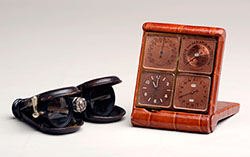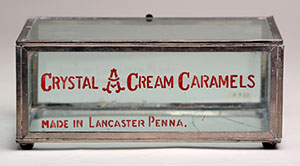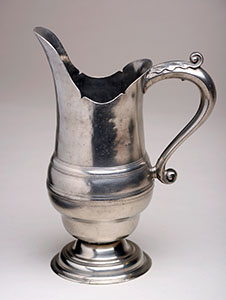The Hershey Story holds, in public trust, artifacts related to Hershey history and American Indian and Pennsylvania German cultures.
 At the core of our mission, we collect, preserve and interpret these artifacts for the benefit of the public. The volume of artifacts, and fragile nature of some pieces, prevent us from displaying all pieces at the same time. When not on display, artifacts are placed in a controlled storage environment where they are preserved for future generations. Other cultural and educational organizations may borrow artifacts on a temporary basis. Researchers are invited to use the collections by appointment; however, the storage facility is not open to the general public.
At the core of our mission, we collect, preserve and interpret these artifacts for the benefit of the public. The volume of artifacts, and fragile nature of some pieces, prevent us from displaying all pieces at the same time. When not on display, artifacts are placed in a controlled storage environment where they are preserved for future generations. Other cultural and educational organizations may borrow artifacts on a temporary basis. Researchers are invited to use the collections by appointment; however, the storage facility is not open to the general public.
The Hershey Story shares information about its collection through print and social media, such as Facebook, X and Instagram.
Read the Curator’s Corner blog to learn about the collections and other related topics
Hershey Collection

Milton Hershey would probably be surprised to find a museum about himself, his community and his chocolate company, but his legacy is one that needs to be shared. The museum began accepting Hershey-related artifacts shortly after Mr. Hershey’s death in 1945. Over the years, they have become the main focus of the collection.

In addition to personal items that belonged to Mr. and Mrs. Hershey, the museum has an extensive collection of product packaging relating to Mr. Hershey’s confectionery businesses dating to 1886, chocolate-making tools and machinery used at the original factory, over 1,500 confectionery molds, and significant examples of promotional materials, such as posters and point-of-purchase displays.

The museum also collects and preserves artifacts related to the community and Mr. Hershey’s non-confectionery businesses, such as Hershey Estates Dairy, the Hershey Transit Company and Hershey Entertainment & Resorts Company. An extensive collection of souvenirs sold at Hersheypark features a nostalgic array of items.
Artifacts in the museum’s collection are available for research. Click here for the researcher registration form and guidelines for accessing the museum’s holdings. Archival holdings, such as manuscripts, organizational records, oral histories, and photographs documenting Hershey are available at Hershey Community Archives.
American Indian Collection
Most visitors to The Hershey Story are often surprised to learn that the museum originated in 1933 as the Hershey American Indian Museum. Mr. Hershey wasn’t American Indian, but he believed it was important to share other cultures with the Hershey community so he founded a museum.
The extensive collection came from John G. Worth, a collector who spent nearly 20 years living in the American West. At Mr. Hershey’s direction, Mr. Worth put together a museum containing material culture created and used by American Indian groups living throughout North America.
The Hershey Story also cares for archeological materials related to the Susquehannock People. It was excavated by David Herr Landis around Washington Boro in nearby Lancaster County. The Landis collection also includes field notes, drawings and photographs.
To better recognize the rights of federally recognized tribes, new regulations of the Native American Graves and Repatriation Act (NAGPRA) went into effect in December 2023. Museums now require consent from lineal descendants and/or culturally affiliated Native American Tribes before allowing any exhibition of, access to, or research of cultural items.
We welcome this opportunity to continue our own learning and deepen our relationships with Indigenous communities. As we undertake this important work and consult with represented communities, researchers will not be able to access the American Indian Collections at The Hershey Story Museum.
Pennsylvania German Collection


In 1933, Mr. Hershey purchased a collection of American Indian items for the newly-created Hershey American Indian Museum. In 1935, he was seemingly intrigued by a new collection of his own heritage – Pennsylvania German. Mr. Hershey’s parents, natives of central PA, were both of Pennsylvania German descent. He purchased the wide-ranging collection from the estate of George H. Danner, a merchant and collector from Manheim, PA. Mr. Danner enjoyed sharing the collection with visitors to his museum, located on the third floor of a dry goods store he operated from 1882 to 1917.
The Danner collection documents the daily life of 19th century Pennsylvania German people. Everyday household items, including 2,000 pieces of English ceramics, glassware and textiles, are the collection’s greatest assets. Notable items include a John Flory blanket chest, a John Long lamp, Lehnware cups and saffron boxes, a 1768 inlaid shrank (wardrobe), and a coverlet made for George Danner’s mother Elizabeth.

Artifacts of particular note are the ironwork and glassware attributed to Henry William Stiegel, an iron master who owned one of America’s first glass works. Other items related to Stiegel include furniture, fireplace tiles and two painted wall-hangings from his mansion. Perhaps the most significant artifact from Danner’s collection is the renowned Apostolic Clock. The clock features a procession of Christ’s twelve apostles. Click here for more information. The Apostolic Clock is currently not on exhibit.
Pennsylvania German artifacts in the museum’s collection are available for research. Click here for the researcher registration form and guidelines for accessing the museum’s holdings.


